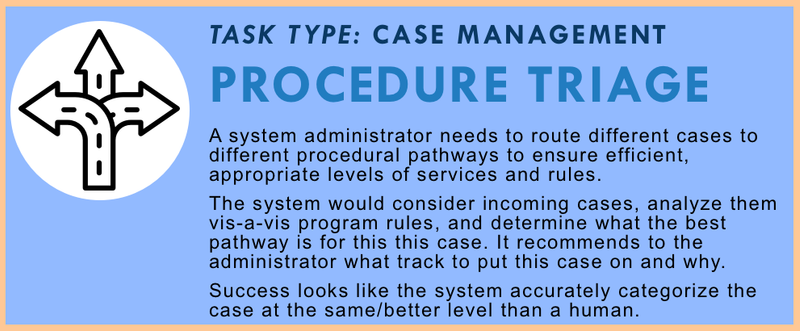Procedure Triage

Route cases to the right procedural track by analyzing case details and matching them to program rules and service levels.
Task Description
In many court systems, administrative agencies, and legal service programs, not every case follows the same path. Some require extensive hearings or legal review, while others qualify for fast-track resolution, diversion, mediation, or simplified processing. Assigning the right track is essential to ensuring fairness, efficiency, and appropriate use of resources.
This task involves a system that functions as a case intake analyzer and routing recommender. As new cases are filed or initiated, the system reviews structured data (like filing type, parties, claimed amounts, or prior history) and unstructured content (like complaints or narratives). It compares this input to the program’s routing rules and decision trees to recommend the correct procedural track.
These tracks might include simplified vs. complex processing, referral to mediation, assignment to specialized dockets, escalation to attorney involvement, or diversion to community resolution programs. The system explains why it chose the track—pointing to matched criteria, exceptions, or historical patterns. It gives the administrator the final say, but does most of the heavy lifting up front.
This task is especially helpful in environments with high case volume and complex or evolving eligibility and triage rules. It promotes consistency in track assignment, helps scale services responsibly, and reduces errors that can delay resolution or misallocate resources.
Success means that the system routes cases with the same or greater accuracy than trained humans—leading to faster, fairer, and more efficient case resolution.
How to Measure Quality?
🧾 Input Data Comprehension
- Parses structured fields (e.g., case type, amount in controversy, dates)
- Extracts relevant information from unstructured documents or narratives
- Flags incomplete or ambiguous information that may affect routing
🧠 Rule-Based Categorization Accuracy
- Applies the organization’s procedural rules and decision criteria to each case
- Correctly assigns cases to tracks (e.g., expedited, regular, high-needs, specialized docket)
- Identifies exceptions or borderline cases with justification
🧭 Recommendation Clarity
- Provides clear reasoning for each routing decision (e.g., “Meets criteria for Track B due to <$5000 claim and no prior history”)
- Highlights key factors that triggered the recommendation
- Suggests alternative tracks if information is updated
✅ Outcome Accuracy and Fairness
- Track assignments match or exceed human administrator accuracy
- Avoids over-escalation or under-serving low-risk cases
- Reflects equity and risk-aware routing across demographics and issue types
🔁 Review and Override Support
- Allows administrators to review, confirm, or override routing decisions
- Logs overrides and tracks agreement rates to improve the model
- Suggests improvements to routing logic based on trends and feedback
📈 Scalability and System Fit
- Works across high-volume and multi-track programs
- Supports jurisdiction-specific and program-specific track systems
- Integrates with intake, CMS, or e-filing systems seamlessly